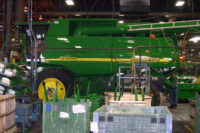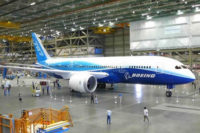MOLINE, IL—Deere & Co. is using artificial intelligence and machine vision to detect and fix porosity defects in welds on its tractors.
Deere uses six-axis robots and gas metal arc welding technology to join various components for heavy equipment. However, finding defects in these welds through manual inspection has proven difficult.
According to a report in the IT journal EnterpriseAI, a pilot program between Deere and chip maker Intel has been making a difference. Using AI and computer vision, Intel engineers developed a system to detect welding issues as they occur and get the process back on track.
“Using a neural network-based inference engine, the solution identifies defects in real time and automatically stops the welding robot,” says Christine Boles, the vice president of the IoT group and general manager of the industrial solutions division at Intel. “The automated system allows Deere to correct the issue efficiently, without slowing down the production line. Together, we are adding intelligence to existing manufacturing equipment, processes and management.”
It’s critical to detect porosity defects in welds. Voids or air pockets can weaken a welded joint. But, finding these defects with machine vision has been difficult because welding environments are extremely harsh, with smoke, sparks and heat creating issues for the camera.
“To overcome these challenges, Intel worked with Deere to put a camera where no human could go: directly on the welding torch, just 12 to 14 inches away from the actual weld,” says Boles. “Utilizing Intel’s AI edge software running on an Intel Core processor-based industrial PC and optimized with Intel’s OpenVINO toolkit, the system examines the streaming video frames and when defects are detected by the AI model, the system is able to stop the weld robot for adjustment in real time.”






